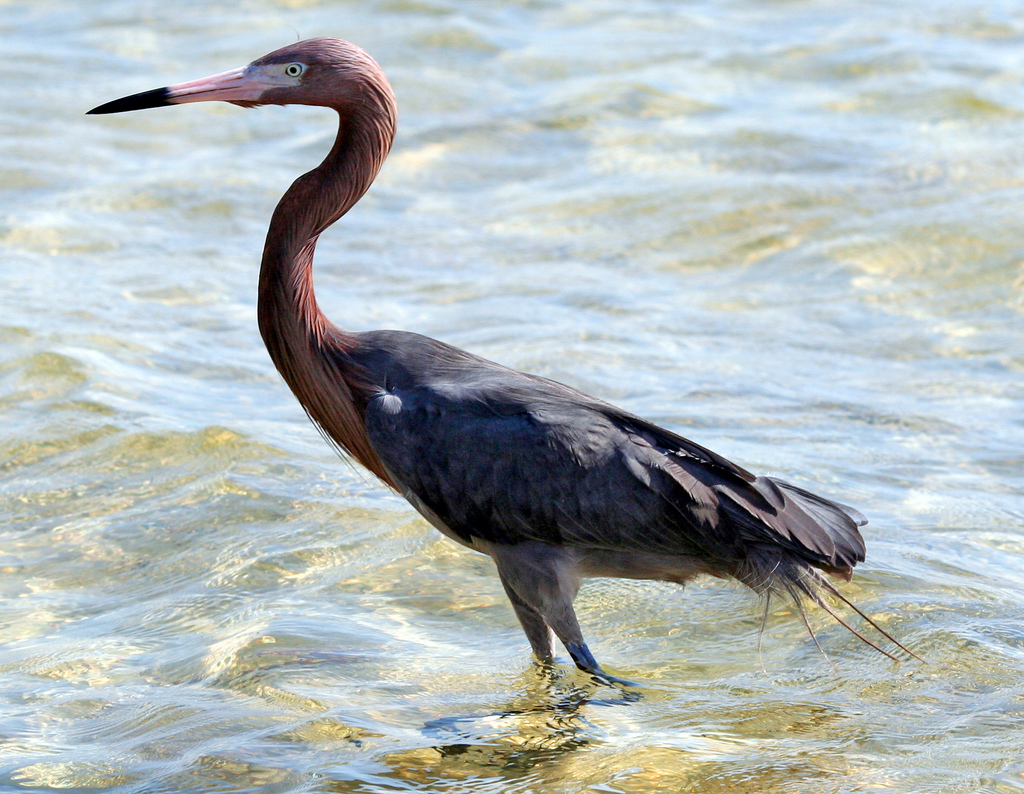- Reddish Egret
Taxobox
name = Reddish Egret
status = LC | status_system = IUCN3.1

image_width = 300px
regnum =Animal ia
phylum = Chordata
classis = Aves
ordo =Ciconiiformes
familia =Ardeidae
genus = "Egretta "
species = "E. rufescens"
binomial = "Egretta rufescens"
binomial_authority = (Gmelin, 1789)The Reddish Egret ("Egretta rufescens") is a small
heron . It is a resident breeder inCentral America , theCaribbean and the southernUSA in the Gulf states andCalifornia . There is post-breeding dispersal to well north of the nesting range. In the past, this bird was a victim of the plume trade.According to the Texas Parks and Wildlife Department (TPWD), there are only 1,500 to 2,000 nesting pairs of reddish egrets in the United States - and most of these are in Texas. [ [http://www.tpwd.state.tx.us/huntwild/wild/species/reddishegret/ Reddish Egret (Egretta rufescens) ] ] They are classified as "threatened" in Texas and receive special protection.
Appearance
This species is about 65cm long, with a 115cm wingspan. It is a medium-sized, long-legged, long-necked heron with a long pointed pinkish bill with a black tip. The legs and feet are bluish-black. The sexes are similar, but there are two colour morphs. The adult dark morph has a slate blue body and reddish head and neck with shaggy plumes. The adult white morph has completely white body plumage. Young birds have a brown body, head, and neck. During mating, the males plumage stands out in a ruff on its head, neck and back.
Behavior
The Reddish Egret is considered one of the most active herons, and is often seen on the move. It stalks its prey in shallow water far more actively that other herons and egrets. It frequently runs energetically and uses the shadow of its wings as to drive prey before it; the result is a fascinating, graceful dance. It eats fish, frogs, crustaceans, and insects. The bird's usual cry is a low, guttural croak.
Reproduction
Reddish Egrets' breeding habitat is tropical swamps. It nests in colonies, often with other herons, usually on platforms of sticks in trees or shrubs. These colonies are usually located on coastal islands. These birds have raucous courtship displays. They general involve shaking of the head during the greeting ceremony, followed by chases and circle flights. They also involve raising of the neck, back and crest feathers, accompanied by bill clacking, similar to the
Tricolored Heron .References
* Database entry includes justification for why this species is of least concern
* "National Geographic" "Field Guide to the Birds of North America" ISBN 0-7922-6877-6
*
* Stokes, Donald W.; Stokes, Lillian Q. "Stokes' Field Guide to Birds: Eastern Region" (1996). New York: Little Brown and Company.External links
* [http://audubon-print.com/reddish-egret.html Reddish Egret by John Audubon]
* [http://www.flickr.com/groups/birdguide/pool/tags/Egretta%20rufescens Field Guide on Flickr]
Wikimedia Foundation. 2010.
